Chennai, October 2004. India, having held Australia to a 1-1 draw on tour less than a year ago, are now engaged in a four-match series against them at home. Australia are one-up, and on the first morning at Chennai the Australian openers re-emphasise their team's superiority with a blustering start. But wickets fall in a heap after lunch as the Indian spinners work out which length to bowl, and halfway into the final session Australia are dismissed for just 235.

|
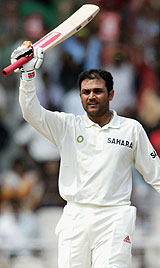
Virender Sehwag celebrates after a hard-working ton against Australia at Chennai
© Getty Images
|
|
India are left with 13 overs of batting before close of play. Of the two openers, Virender Sehwag and his new partner Yuvraj Singh, it is clear who bears the weight of responsibility. Eight months previously, on the first day of the Melbourne Test, Sehwag had plundered 195, his highest Test score. Of course, the quality of the attack he took on there did not bear comparison to the line-up Australia have now brought to India: Glenn McGrath, Jason Gillespie, Michael Kasprowicz, and Shane Warne. But Sehwag, too, has made great strides as a Test batsman in the interim. On the series in Pakistan that followed the tour of Australia, he had battered 309 at Multan. Now, over the first two days at Chennai, Sehwag almost singlehandedly keeps India's pursuit of the Australian total going as his partners are dismissed one by one. By the time India go past Australia's 235, Sehwag has already aggregated 155 of those runs.
Of his 10 Test hundreds, Sehwag's 155 was by no means the most attractive. But it was the hardest he has ever had to work for his runs, and he fought a running battle against a very good attack featuring two of the greatest bowlers in the history of the game. Cricinfo Magazine took some video footage along on a visit to Sehwag's home in Delhi's Najafgarh to revisit the innings in depth.
In the 13 overs you had to bat on the first day, you played really cautiously by your standards - you left a lot of balls alone, and at the end of the day you'd scored only 20. How did you approach that session?
(
Watching McGrath bowling the first over of the innings to Yuvraj) Those last few overs of a day are very important. So you have to play with a lot of care and make sure you don't make any mistakes. Also, before this I'd had a flop season in one-day cricket, and I was very conscious about getting a good start and getting my form back. At Bangalore I'd got a decent start in the first innings before getting out, and in the second innings I'd got a bad decision. So I was keen to get a good start and build on the advantage the team had gained. Also, in the first Test our middle-order batsmen hadn't made too many runs and they were under pressure. All these things were on my mind that evening. I wanted to play my shots only when I got my flow back and felt settled.

|
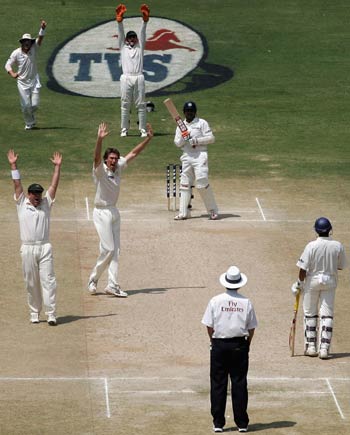
Sehwag got a rough decision in the second innings in the Bangalore Test
© Getty Images
|
|
The heat in Chennai was sapping...
Yes, it was very hot. But we were so excited after bowling them out that we didn't feel much weariness. At Bangalore Australia had made over 500 runs against us and then bowled us out cheaply twice. But now we'd bowled them out on the first day itself for 235.
Sehwag prepares to face his first ball, from Jason Gillespie, and plays it down defensively. The next ball keeps low and scuttles beneath his bat. Sehwag looks somewhat perplexed.
When that happens on a first-day pitch what does a batsman think?
That was really the first ball in the whole day which had kept low like that. Sometimes it's actually the bowler who's bowling looseners and that's why the ball doesn't bounce. Gillespie hadn't warmed up properly.
How did you assess the pitch itself, after 10 wickets had fallen on the first day?
Oh, the pitch was fine. Wicket se to ek bhi batsman out nahin hua. It's only that the spinners were getting good bounce from it - that's a characteristic of the Chennai pitch.
You'd faced Gillespie on the tour of Australia in 2003, but McGrath and Warne were absent then. Had you ever faced either of these bowlers?
Only once, at Bangalore during the one-day series of 2001. I got a fifty. After that I dropped out because of an injury.
Had you made any kind of special preparation for McGrath, considering you were going to be facing him first-up in every innings?
No special preparation as such, but when we discussed him Sachin, Rahul and Sourav always used to point out that he bowls an excellent line and length just outside off stump. If you leave him alone, and let him attack your stumps in order to make you play, then it's easier to play him. If you chase him, go after him, he'll have you in trouble.
McGrath also has a reputation for sledging. Did he try that with you?
Well, he tries that strategy to mess with the batsman's concentration and to get him to play a rash shot. But I don't think a good batsman allows these things to upset him.
Should a batsman respond to sledging?
Some batsmen do, some don't. When I respond to a bowler's verbals, I become determined not to lose my wicket to him.
Sehwag proceeds to play out the first spells of McGrath and Gillespie with great care. With three overs left, Adam Gilchrist brings Warne on to bowl, and Warne duly dismisses Yuvraj. Sehwag plays only one ball from Warne that evening, but to that one ball he essayss a quite exceptional stroke.
Warne bowls over the wicket to Sehwag, a legbreak pitching outside leg stump - his stock delivery to right-handers. But Sehwag's front foot not only advances down the pitch but goes away towards the leg side, following the line of the ball instead of allowing it to spin across him. He gets to the pitch and flicks it to deep midwicket against the spin for a single. Both bowler and wicketkeeper let out stifled cries at this risky stroke.

|
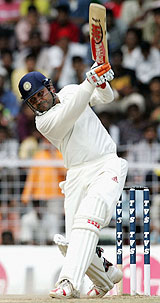
Sehwag drives on his way to a hundred
© Getty Images
|
|
Why did you play that ball the way you did?
Simply because there was no fielder at midwicket, only one at deep midwicket. So even if the ball went a little uppishly there was no chance of my getting out. When I took guard against Warne I looked carefully at what kind of field he'd set and I fixed on my shots accordingly. My plan was to get a single as quickly as possible instead of allowing him to pressure me.
When you play all six balls from a bowler, obviously your chances of getting out are higher. If you rotate the strike - especially when you're a right- and left-hand combination as we were here - then it becomes much harder for the bowler to build the pressure. Pressure only builds if you're stuck at one end, beaten two balls, then made to play the next four but can't get them away for runs.
Sehwag finishes the day on 20 not out. The next morning, mindful of their small total, the Australians set defensive fields and give nothing away. McGrath and Gillespie, bowling with just one slip and a ring of fielders on both sides of the pitch, keep Sehwag and night-watchman Irfan Pathan down to just a trickle of singles.
Did it bother you that the runs were so difficult to come by initially?
Our plan was to not lose a wicket in the first hour, whether we scored 10 runs or 20. It was so hot that we knew that after the first hour the bowlers would begin to tire - and they only had one spinner - and it would be easier to play them when they returned for their second spells.
Did you find the Australian approach in the field very different from when you played them last?
Yes, completely different. In 2003 their bowling attack was different every match. (He names, without mistakes, the different bowling combinations in each Test on the series of 2003-04.) This time they had a settled bowling attack who could execute a plan. They had decided they would not repeat the mistakes of 2001 or even of 2003-04. They weren't going to let us score as quickly as we'd done in the past. As soon as they sensed that a batsman was gaining control, they'd put deep fielders back in the areas where boundaries were coming and try to stifle the runs.
Only six runs have come in the first half-hour when McGrath decides to go around the wicket to Sehwag. Instantly something changes about Sehwag's demeanour, and he begins to aim a shot at every ball. An inside edge flies past leg stump for four, and the next ball is sent rocketing through point for another boundary. McGrath is taken off, but when brought back to bowl a few overs later, he persists with his round-the-wicket line. Sehwag erupts once again and takes 10 off the over.
Why did you take on McGrath when he came round the wicket?
When a bowler is bowling over the wicket, there is less margin for the batsman to manoeuvre. The ball is coming down a very straight line, and if you want to play shots then there's a chance of it flying off the edge to slip. But when the angle of delivery changed, the ball was going across me and there was a little room to play. Then after those boundaries off McGrath, I hit two boundaries in the next over off Warne.
Were there any shots you consciously avoided on this pitch?
Yes. The ball wasn't really coming onto the bat, so I looked to eliminate the square-cut - it's a dangerous shot to play on a pitch like this because there's a chance of getting an inside edge and playing onto your stumps. So I only played the back-foot punch with a straight bat to short-of-length balls. But on a pitch where the pace and bounce are true, it's better to cut with a horizontal bat and avoid the back-foot punch.
Sehwag hits a series of boundaries, all to leg, against Warne and reaches his fifty.
When you attacked Warne in this Test it was always with one of two shots: that flick through midwicket we just talked about, or the sweep or slog-sweep square of the wicket.
My plan was that if Warne bowled to me on my legs I'd play him to midwicket or square leg instead of the off side. He gets so much turn that I felt that if I tried to drive him through the off side then there would be a chance of an edge. In fact I did give one chance like that and was dropped by Matthew Hayden at slip. But there was always a single on offer to midwicket, and if I got it into the gap then it was four.

|
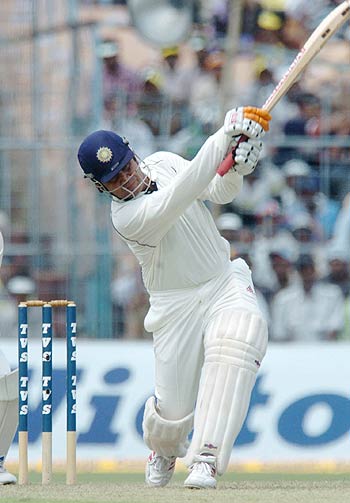
'In my batting the pad has no role. When I go out to bat I never think of indulging in deliberate padding'
© Getty Images
|
|
Before the series I sat down with our computer analyst and watched a lot of footage of Warne - his bowling when he last came here in 2001, and also footage of him bowling against other teams. You'll remember that when Laxman made that 281 against Australia, he went for his shots against Warne, whether he was bowling over the wicket or round the wicket. But many batsmen look to play Warne defensively, or leave a lot of his deliveries, and that's when they get into trouble. For example, in that same series Rahul Dravid once tried to leave Warne but the ball bounced out of the rough and took his glove, and he was caught behind. If you don't play with the bat then you also allow the ball to turn. If you reach out to play then you don't give it the chance to turn.
Many right-handers look to pad Warne away when he bowls outside leg stump. Did you never consider this?
In my batting the pad has no role. When I go out to bat I never think of indulging in deliberate padding.
You played a lot of high-quality legspin bowling that season - first Warne, then Danish Kaneria. How would you compare the two bowlers?
I think Warne has greater variety than Kaneria. Warne has a great idea of how to work a batsman over: how to make the batsman play four balls in a certain way and then do something else with the fifth; when to bowl the googly and which ball to push through straighter; which one to flight and which one to push through flat; which ball to spin more and which one less. Danish doesn't have all that yet. Control zyaada Shane Warne ka hai, idea zyaada usko hai, knowledge zyaada hai ki Test cricket mein batsman ko kaise out karein. It's experience.
An old paradigm of cricket was that once you saw off the new ball it became much easier to bat. But in this series the Australians were beginning to get the ball to reverse swing quite sharply by the time it was 30 or 35 overs old.
Yes, but with reverse swing you can tell which way the ball is going to swing by looking at the shiny side. With the new ball sometimes it's not possible to tell whether it's going to swing in or out, or even how much it's going to bounce. So when the ball gets older and softer I'd say it gets easier for the batsman even if it reverse swings.
Sehwag goes in to lunch 61 not out, having added 41 to his score in the morning session.
After lunch it seemed that you deliberately stepped up a gear in the company of Dravid. You took a number of risks against Darren Lehmann's bowling.
By the time Lehmann was brought on I was already in the nineties. I knew what their planning was for me. The field was back - they didn't want to allow me to score quick runs. So I knew what he was going to bowl.
Lehmann aims the ball at Sehwag's stumps from wide of the crease, tempting him to hit against the spin. Sehwag takes up the challenge and shovels him repeatedly to wide long-on for singles and boundaries. At one point, after Sehwag takes a single, Lehmann is seen pretending to take a caught-and-bowled. Sehwag indulges in some banter with the bowler as he reaches the non-striker's end.
What were you telling him there?
It was just good-natured teasing. I said, "You're bowling too slow, so you'll hardly get a caught-and-bowled." (laughs)
Sehwag motors on towards his hundred. He offers another half-chance in his nineties, as a miscued lofted drive to a slower ball from McGrath just eludes Simon Katich running back from cover. Now Sehwag late-cuts Kasprowicz to move to 99 and then steers him through the covers to bring up his hundred. His last 50 runs have come in just 56 balls.
Soon after Dravid was out, wickets fell quickly, (India slipped from 178 for 2 to 213 for 5), and the Australians sensed an opening. Sometimes in such situations the established batsman plays more cautiously. But you continued to go after the bowling.
It depends on what kind of game the batsman has. My game is an attacking game and I know what kind of shots to play and when to play them. Whether wickets are falling or not, a loose ball is a loose ball.
One feature of this innings was that you played the faster bowlers mostly on merit, but you went after the spinners.
We (Indian batsmen) always play the spinners well. The run-rate had to be raised at some point. If you play slowly from both ends and don't take your chances, then you will get out eventually.
How taxing was it, batting against an attack with four good bowlers?
Until you're set you always have the fear that you could be out at any time. But once you're in you know that today it's this bowler or this particular shot that can get you out. That day when I was batting I never did feel that McGrath, Gillespie or Kasprowicz could get me out. I was concerned that I might get myself out playing shots against the spinner or the part-time bowler. undefined
Sehwag does indeed fall to spin eventually, mistiming a pull off Warne and holing out on 155.
Even when I did get out, the ball was actually short and there to be hit. But it turned and bounced more than I expected and took the top half of my bat.

|
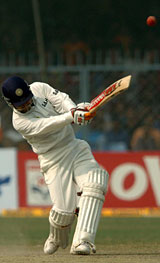
'Whether wickets are falling or not, a loose ball is a loose ball' - Sehwag
© Getty Images
|
|
The 155 was not Sehwag's only contribution of the match. For sheer drama his brief second-innings knock was almost its equal. India ground out a lead of 141, but Australia's resistance in the second innings was worthy of a champion side. Despite being four down for 150 - effectively 9 for 4 - at stumps on the third day, they still managed, thanks to Damien Martyn and night-watchman Gillespie, to bat for almost the whole of the fourth day. India were finally set 229 to win - more than had ever been made in a successful fourth-innings chase at Chennai. After their labours in the field in the sapping heat, Sehwag and Yuvraj again had the thankless task of seeing out a short passage of play before the close - this time only three overs.
What were the two of you thinking when you went out to bat?
We were determined not to lose a wicket. Otherwise it would have become difficult for us the next day.
How does the other team come at you in situations like this? Do they try to unsettle you even before a ball is bowled?
Hayden talks quite a bit. He was saying things like "This is not the time for openers" and "Let's see how many boundaries you'll hit."
Did you have butterflies in your stomach as you took guard?
Every batsman feels the tension until the first ball is bowled. Then you enter into the game and the nervousness goes away. That's why I prefer not to take first strike. When the first ball has been delivered, or the first over has gone, I feel normal.
Yuvraj appears a bundle of nerves against McGrath - he is nearly knocked over second ball by a bouncer, and he edges the fourth ball just wide of third slip for four. Next ball he manages to get off strike. Sehwag now takes guard to McGrath, and calmly deflects his first ball wide of gully for four.
Bowlers are always trying to read the minds of batsmen. Does it work the other way as well? When you took guard before the last ball of McGrath's over, were you thinking about what kind of ball he'd come up with?
In these last overs of the day everyone knows that the bowler will try to make the batsman play as much as possible. I knew that McGrath would bowl at my off or middle stump and not outside that line because his goal that evening was to get me out in his two overs. If you look at McGrath's first delivery to Yuvraj in the first innings, you'll see it was this wide of off stump (indicates it was about a foot wide). But in the second innings his first ball is right at his off stump. That's the difference between having 13 overs and three overs to bowl.
The second over, bowled by Gillespie, passes without incident. But when Sehwag gets on strike, the bowler makes one rather unusual field placing.
You'll see here that Gillespie places a deep square leg for you from the first ball instead of a normal square leg saving the single. But you hardly play the pull or the hook. Why did he do that?
That's because the target they'd set us was not a big one. And as I said, when only three overs remain before the close then the bowler has to bowl at the stumps. In normal circumstances if he'd done that and I'd played the flick, I'd have got four for it, but now if he strayed onto my legs I'd only get one. He was trying to save three on a possible error because they didn't have many runs to play with.
Gillespie's over passes without incident. Now McGrath lopes in for the final over of the day. Three days previously Sehwag had worked a single off the first ball of the last over of the day, and Yuvraj, given the strike, had lost his wicket. Now it is Yuvraj who pushes the first ball towards mid-on and scampers a single, bringing Sehwag onto strike. McGrath's third ball is just a touch shorter than his usual length. Sehwag hangs back and lashes it in front of point for four. But when the bowler pitches it further up, Sehwag plays in the V.
You're looking to play McGrath very straight here.
In the Bangalore Test he'd got three batsmen out with deliveries that pitched and then darted back in. I didn't want to attempt the flick because if he produced another ball like that then there'd be a good chance of him getting me out lbw.
Now only the last ball of the day remains. McGrath walks back to his mark, turns, runs in and bowls a length ball just outside off stump. Sehwag's hands go out at the ball and he rifles it back past the bowler's left hand for his third boundary of the evening. The crowd erupts; Sehwag strides off quickly, chin up, leaving the Australian fielders in his wake. India have finished with 19 for no loss.
From your body language as you left the field it seemed that that you were trying to tell the Australians...
(Interrupting) ...ki hum log kal jeetne waale hain. (That we're going to win tomorrow.) It's important to have positive body language in such situations. You have to show the other team that you're here to win.
When you walked off at the close of the first day you were making small talk with the Australians. This time you just strode off...
Because I still had work to do the next day.
Heavy rain the next day denied Sehwag the chance to build on his work of the previous evening, and washed out a Test match that was poised for a thrilling finish. India subsequently lost the series 1-2.




